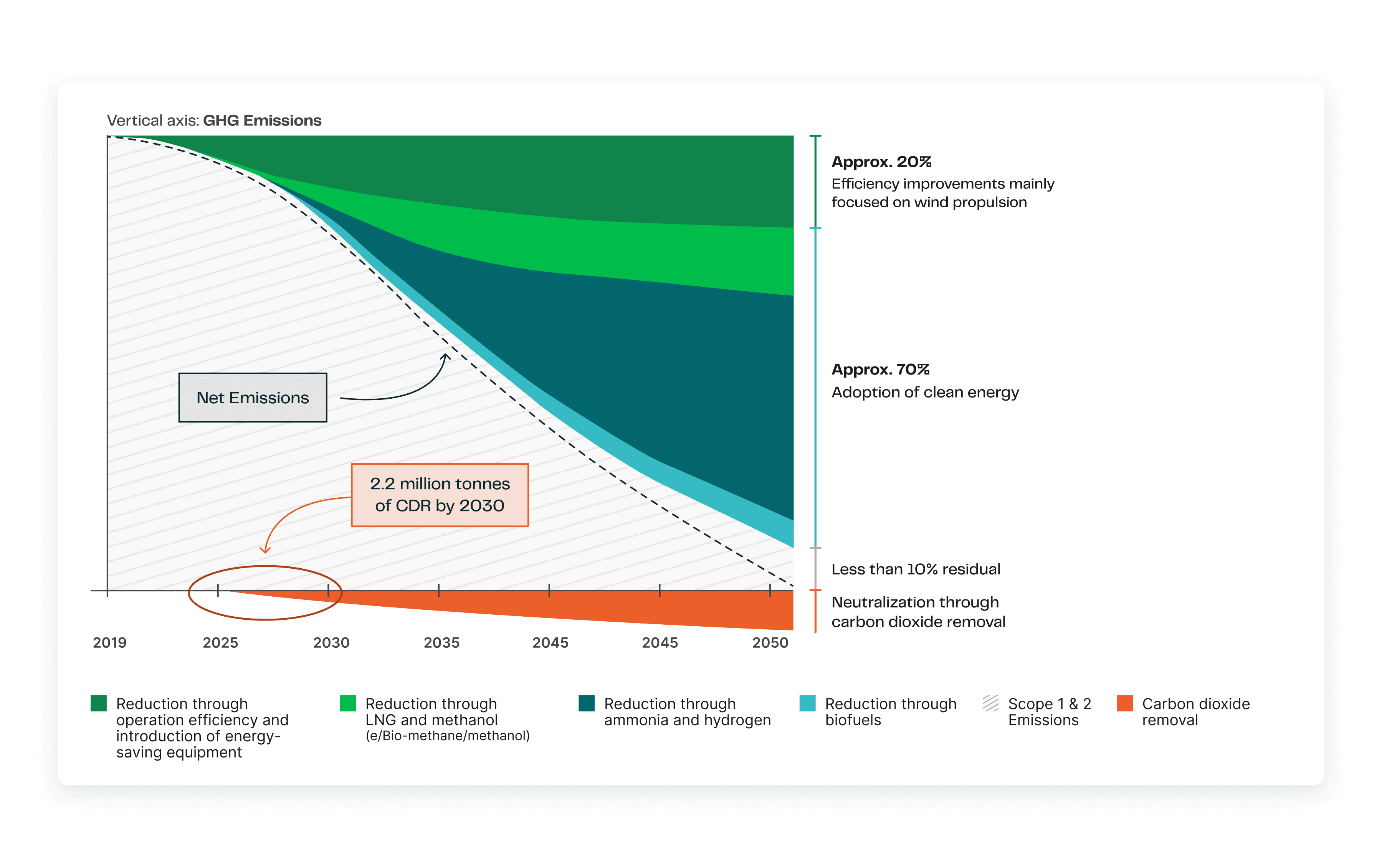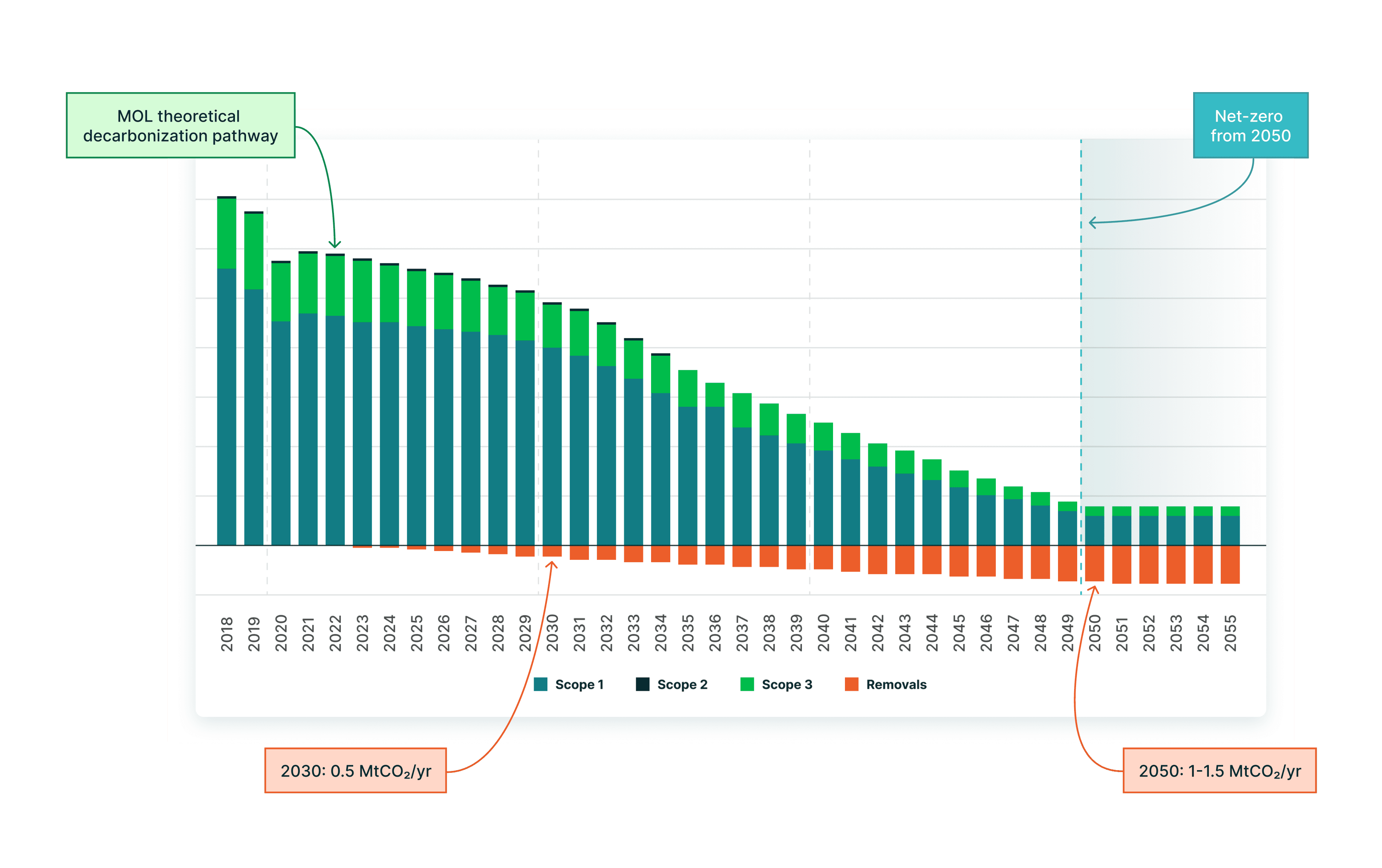
Mitsui O.S.K. Lines charts path to decarbonize maritime transport
"We chose Carbon Direct because of their work with Microsoft and other ambitious companies around carbon removal. They are the experts."
Kazura Koda
General Manager of the Carbon Desk, Mitsui O.S.K. Lines
About Mitsui O.S.K. Lines
Mitsui O.S.K. Lines (MOL Group) is one of the largest shipping companies in the world. Throughout their near 140-year history, the Japan-based MOL Group has grown their fleet to nearly 800 vessels and has implemented values-aligned strategies for social action and environmental conservation. To achieve their mission of ensuring a prosperous future, MOL Group is leading the shipping industry in marine conservation, biodiversity protection, and climate change mitigation.
Results
Creation of industry benchmarks and KPIs to track progress towards MOL Group’s goals for carbon dioxide removal, as a complement to their large-scale emissions reduction
Risk mitigation analysis on market engagement strategies across direct procurement, forward procurement, and project development
Curated portfolio recommendations for nature-based, hybrid, and engineered carbon removal credits to compensate for residual emissions over time
Whether it’s clothes, gasoline, pharmaceuticals, food, or batteries, nearly 100,000 commercial shipping vessels move 11 billion tons of goods annually—that’s 80% of everything traded globally. The continued growth of international commerce is anticipated to triple maritime trade by 2050, and without massive decarbonization, that growth stands to undermine the goals outlined by the Paris Agreement.
Today, maritime transport is responsible for 3% of global CO2 emissions—more CO2 emissions than from aviation. That carbon footprint could increase 40% by 2050 under a business-as-usual scenario. To address these growing emissions, the International Maritime Organization (IMO) introduced the first emissions reduction target for the international shipping industry in 2018*: reducing total annual GHG emissions by at least 50% by 2050, with the goal of reaching net zero by 2100.
As one of the largest shipping companies in the world, Mitsui O.S.K. Lines (MOL Group) decided to set an even more ambitious goal to galvanize the harder-to-abate shipping industry: achieving net zero by 2050. This requires not only implementing massive reductions in their Scope 1, 2, and 3 emissions, but also laying out a pathway for carbon removal credits to compensate for residual emissions.
“When we set this goal, there were no competitors or actors in other harder-to-abate sectors who were doing anything like this,” says Kazura Koda, General Manager of the Carbon Desk at MOL Group. “We realized that by mapping out a step-by-step approach for an ambitious carbon removal plan, we could actually help to shift the maritime transport industry as a whole.”
After announcing the 2050 net zero target in their 2021 Environmental Vision 2.1, MOL Group worked with Carbon Direct to build on existing carbon reduction efforts by providing insights into how to incorporate high-quality carbon removal credits into a holistic carbon management strategy.
“We are figuring out how we can continue to support international trade today, while also being responsible for future generations,” says Kazura. “To do that, we need emissions reduction and carbon removal. We chose to work with Carbon Direct because of their work with Microsoft and other ambitious companies around carbon removal. They are the experts.”
Achieving ambitious emissions reduction with data-driven targets
An effective carbon management strategy starts with accurate, science-based measurement, followed by a heavy emphasis on emissions reduction.
MOL Group’s focus on science informed their adoption of this approach. Using benchmarks from both the Science Based Targets Initiative (SBTi) and the shipping sector of the First Movers Coalition (FMC), MOL Group set two operative goals:
Reduce the GHG emission intensity of their Scope 1 emissions by 45% by 2035
Reduce their total Scope 1, 2, and 3 emissions by more than 90% by 2050
To achieve this, MOL Group will need to implement massive emissions reductions across their fleet at the multi-megatonne scale.
“Decarbonizing all of our fleet will be difficult, but we are working on emissions reductions that can be implemented now, such as immediately starting the use of liquified natural gas (LNG), a low-emission alternative marine fuel,” says Kazura.

Carbon Direct worked with MOL Group to examine their emissions reduction curve against science-based targets, and from there, develop an emission-mitigation hierarchy based on their 2021 emissions profile—starting with the reduction of Scope 1 emissions. With MOL Group’s near 800-vessel fleet, Scope 1 emissions make up 80% of their total carbon footprint. Modeling the impact of fuel switching across LNG, biofuels, ammonia, and hydrogen fuels on Scope 1 emissions reduction enables MOL Group to plan for various scenarios on the way to their 2050 net zero target.
“A huge challenge for the shipping industry is anticipating which technology will become the dominant one,” adds Yosuke Ueda, Deputy General Manager, Energy Business Strategy Division at MOL Group. “The supply chains have not been established yet, so we need to understand all of the options to ensure the future of our business.”
“To ensure we achieve net zero by 2050, we have set quantitative KPIs and milestones to measure the progress of each action that we take and have refined our net-zero pathway as a part of our updated Environmental Vision 2.2,” says Kazura.
Developing a holistic carbon removal management strategy with Carbon Direct
While Scope 1 emissions reductions are critical to MOL Group’s decarbonization strategy, they still anticipate residual emissions that will need to be removed to achieve net zero.
“The emissions for harder-to-abate sectors are huge. We tend to think that emissions reductions are sufficient, but they’re not,” says Kazura. “Globally, we have a limited carbon budget so we have to do whatever we can as soon as we can. That includes carbon removal.”
For MOL Group, it is not tenable to wait until 2050 to buy the carbon dioxide removal they will need to compensate for the residual ~10% of their emissions after decarbonization. They need to build the carbon removal market first to be able to support that level of demand.

To help with this, Carbon Direct developed a comprehensive carbon removal strategy to help MOL Group understand how the carbon removal landscape will develop in the coming decades, how to establish purchasing timelines based on carbon dioxide removal technology development, and how to identify projects to support with annual procurement and investment budgets.

Based on MOL Group’s impact goals and priorities, Carbon Direct recommended a carbon removal portfolio strategy that demonstrates a market commitment to complement its prioritization of Scope 1 decarbonization. This approach will allow MOL Group to gain market experience, signal market commitment to carbon dioxide removal suppliers, and also support near-term climate change mitigation efforts.
To execute this purchasing pathway, Carbon Direct developed a scenario analysis of diversified carbon removal portfolio and market engagement options that would maximize climate benefits and minimize potential risks for MOL Group. Of these options, Carbon Direct recommended a blended portfolio of nature-based, hybrid, and engineered carbon removal credits. Nature-based credits will allow MOL Group to begin supporting the carbon removal market and achieve near-term mitigation today as they evaluate forward procurement and project development options for hybrid and engineered carbon removal credits in the future.
“We need to plan for a high-quality portfolio of carbon removal credits now,” says Kazura, adding, “we want to ensure that it’s not only about carbon, but also co-benefits like biodiversity and supporting livelihoods of local communities.”
What’s next: activating a multi-decadal climate action plan
MOL Group is currently participating in the development of a blue carbon project to restore and protect mangroves in Indonesia**. They also plan to expand their support of nature-based projects in the future, while also exploring purchasing options for next-generation carbon dioxide projects. These steps are part of MOL Group’s long-term climate action plan to build their diversified portfolio of carbon removal credits based on Carbon Direct’s science-based recommendations.
“With Carbon Direct, we’re building our portfolio step by step so that we have the negative emissions we need to meet our net zero goal in 2050,” says Kazura.
Learn more: Explore carbon management solutions for sustainable transportation >
—
*The IMO adopted an initial strategy in 2018, which was revised in 2023 with strengthened ambitions.
**The YL Forest Co., Ltd project has not been evaluated by Carbon Direct. Inclusion of YL Forest Co., Ltd in this case study does not represent an endorsement of this project.
